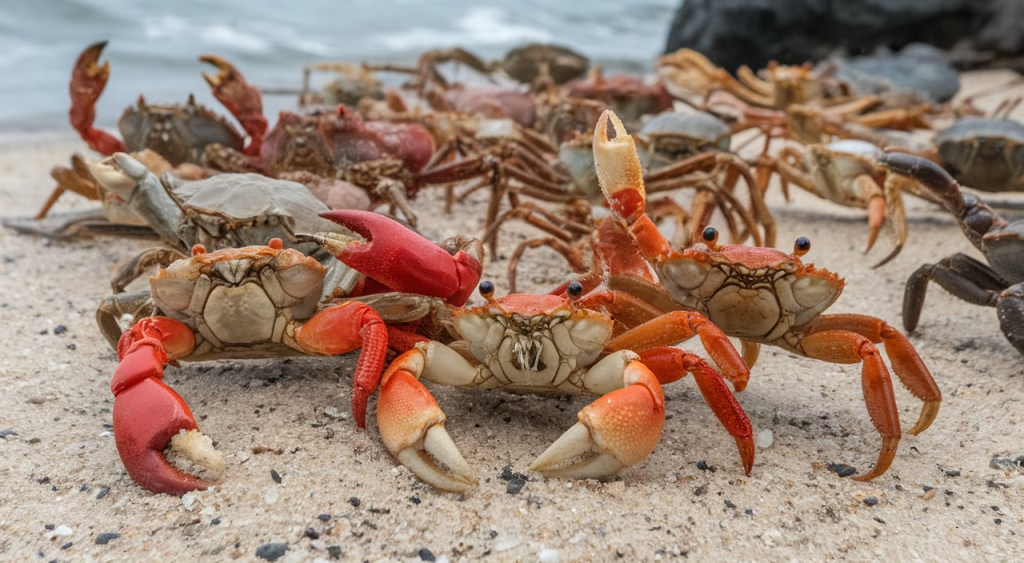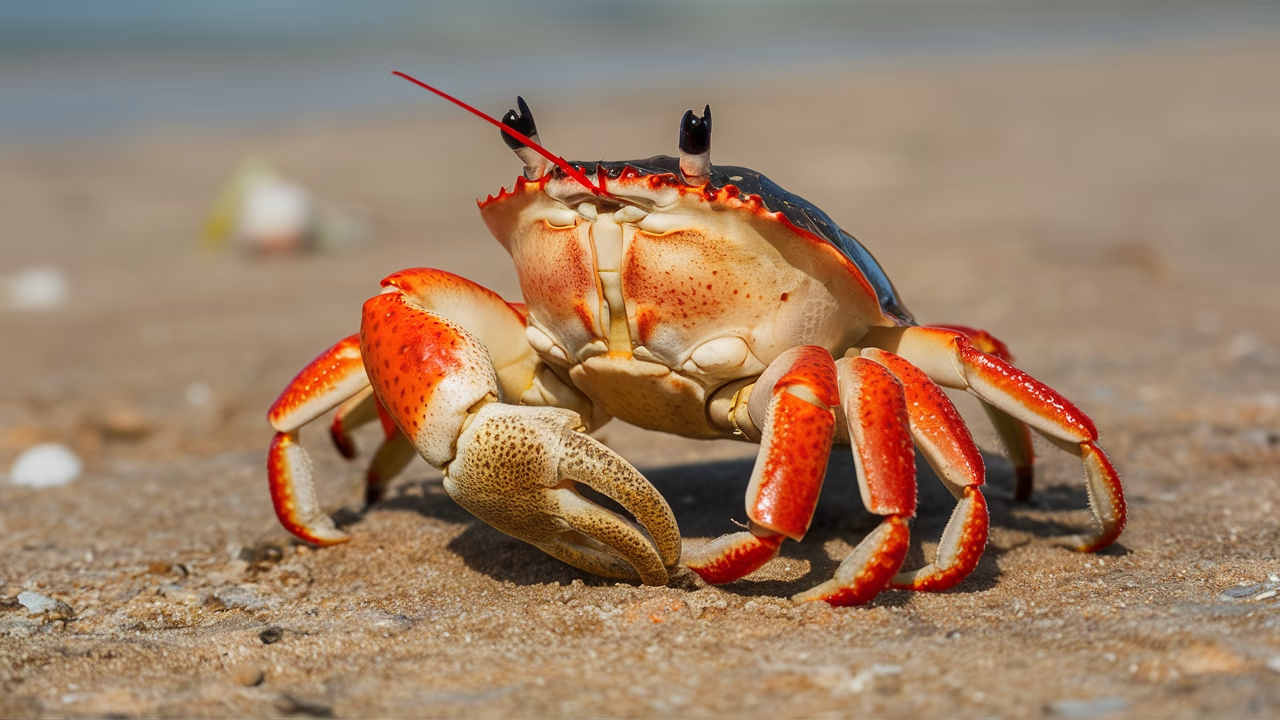How Do Crabs Communicate Without Sound?
Crabs communicate through a fascinating mix of body language and vibrations—waving claws, drumming on the ground, and even sending seismic tremors through sandy shores. But how exactly do these marine crustaceans make this silent language work in the underwater world?
TL;DR: Cracking the Code of Crab Communication
- Crabs don’t talk—they wave, drum, and shake to get messages across.
- Fiddler crab communication involves dramatic claw-waving used to court mates or warn rivals.
- Crab drumming signals involve tapping or vibrating their shells or limbs against surfaces like sand or rocks.
- Seismic communication lets crabs broadcast signals through the substrate—like secret Morse code under your feet.
- Communication evolves differently across species depending on environment, predator pressure, and mating strategies.
Understanding Crab Communication Through Claw Waving
Ever watched a crab wave a giant claw like it’s hailing a cab? That claw waving behavior isn’t just for show—it’s profound marine crustacean communication in action. Among the most fascinating examples of this behavior is found in fiddler crabs (Uca spp.). These remarkable creatures have evolved one oversized claw which they use for both defense and display.
Male fiddler crabs stand outside their burrows, raising and waving their enlarged claw in an almost rhythmic motion. To us, it may look like a tiny semaphore message. But to nearby rivals and potential mates, these claw movements say volumes: “This is my territory,” or “Hey there, lovely—fancy a burrow mate?”
Fascinatingly, female crabs don’t just go for size—they’re also measuring the wave’s tempo and consistency. This tells them a lot about a male’s stamina and precision, which may correspond to genetic fitness. Yes, in the world of marine crustaceans, even swinging a claw has evolved into a fine-tuned mating ritual.
The Science Behind Crab Claws
At a structural level, the muscle building the fiddler crab’s enlarged claw is remarkable. While it might look cumbersome, different species balance trade-offs between size and speed in their claw waving displays. Some species wave big and slow, projecting dominance; others wave smaller claws rapidly, signaling tact or agility. Scientists studying crab claw waving as a modeling system for sexual selection have even likened it to a form of bio-mechanics-based language.
Deciphering the Rhythms: Drumming Signals in Crabs
Claw waving isn’t the only way crabs talk. They also drum—not with sticks, but with their own bodies, producing low-frequency vibrations you’d need sensitive equipment (or super-attuned crab limbs) to detect. In some species, especially ghost crabs (Ocypode spp.) and certain land crabs, males create crab drumming signals by rhythmically beating their claws or body parts against hard surfaces or within their burrows.
This behavior can be both territorial and sexual. In close quarters or poorly visible environments, drumming signals can reach potential mates or ward off competitors when visual line-of-sight is interrupted. It’s like sending out a rhythmic email, encoded in beats.
How Crabs Use Drumming for Communication
The structure of these vibrations can vary dramatically. Some crabs tap in bursts. Others use sustained tremors. Interestingly, these patterns are species-specific in marine crustacean communication. It’s essentially a built-in identity card saying, “This is who I am and what I want.” In one study, researchers observed that certain ghost crabs even modified their drumming frequency depending on the presence of predators—that’s some serious communication adaptability.
Unveiling the Seismic Signals of Fiddler Crabs
The ground isn’t silent—at least not if you’re a fiddler crab. As burrow-based creatures, they use seismic signals much like human engineers use vibration sensors to detect underground structures. Through rapid movements inside or outside the burrow, male crabs create subtle tremors. These pass through the sandy substrate and are detected by the highly sensitive leg hairs of other crabs.
What’s revolutionary here is the use of the substrate itself as a medium for marine crustacean communication. Sound doesn’t travel well underwater for close-range communication, so evolution’s workaround is to use vibrations—like tuning forks in mud.
Impact of Claw Size on Seismic Encoding
Recent research suggests that the size of the fiddler crab’s claw not only influences claw waving gestures but also affects how intense the seismic signal is. Think of it as both the antenna and speaker—providing volume, direction, and frequency. These signals can be measured, graphed, and categorized much like linguistics maps languages.
The Evolution of Crab Communication Methods
Crab communication didn’t pop into evolution fully formed. Over millions of years, marine crustaceans responded to pressures like murky water, predation, and competition for mates by developing ever more diverse signaling strategies. Just like humans evolved different languages and dialects, crabs evolved different forms of movement-based languages.
Environmental context plays a huge role in shaping these communication methods. Fiddler crabs living on muddy estuarine flats favor seismic signals because of substrate properties. Coral-dwelling species may rely more on claw displays visible over short distances. Some land crabs favor loud shell tapping due to more stable ground conditions. Behavioral flexibility is key—many crabs engage in multimodal signaling, using both visual claw waving and vibratory cues depending on the situation. It’s the Swiss Army knife of survival tactics.
Practical Observations and Research Insights
As marine biologists, we spend hours—all-day cycles in tidal flats just observing crab communication up close. Trust me, from experience, it’s like watching a theater of gestures. One moment, a crab is frantically engaging in claw waving to establish dominance. The next, another is quietly pulsing the earth with drumming signals for the attention of a shy neighbor, hiding inside her burrow.
Some key real-world insights into marine crustacean communication include:
| Observation | Behavior Interpretation |
|---|---|
| Claw waving with frequent rhythm | Mating readiness |
| Sporadic and slow waving | Territorial warning |
| Sustained drumming in burrow | Mate attraction |
| Rapid vibration outside burrow | Predator alert |
These field notes serve not only as fascinating insights into fiddler crab communication but potentially critical data points for conservation and species identification, especially with ongoing habitat loss in coastal regions.
Final Thoughts: Why Crab Communication Matters
So, what does all this mean for you—the curious science enthusiast peering into tidal zones? Next time you’re snorkeling over a seagrass bed or walking near a mangrove slit, pause. Watch closely. That little twitch or wave might be a heated argument, an impromptu dance, or a heartfelt love note in the language of legs and claws.
Understanding marine crustacean communication isn’t just niche science—it gives us broader insight into how evolution crafts language without sound, how animals innovate expression, and how vital habitat shapes behavior.
Frequently Asked Questions
- Do crabs communicate with their claws? Yes, many crabs—especially fiddler crabs—use claw waving for visual signaling, waving to attract mates or defend territory.
- What are drumming signals in crabs? Crab drumming signals are rhythmic taps or vibrations created by crabs using their claws or bodies to send communication via the ground or burrow walls.
- How do fiddler crabs use seismic communication? They generate vibrations through the ground using leg movements or claw tapping, which others detect using specialized limb hairs.
- Is crab communication species-specific? Absolutely. Each species has distinct patterns of marine crustacean communication—different rhythms, tempos, or claw shapes—that helps avoid cross-species confusion.
- Can crabs hear these signals? Not in the traditional sense—they detect vibrations through mechanoreceptors, especially in their legs.
- Do female crabs communicate too? While males often initiate courtship or territorial displays, females respond with movements that indicate receptivity or rejection.
- Why is understanding crab signaling important? It helps scientists track species health, mating success, and behavior changes linked to environmental stress or climate change.





